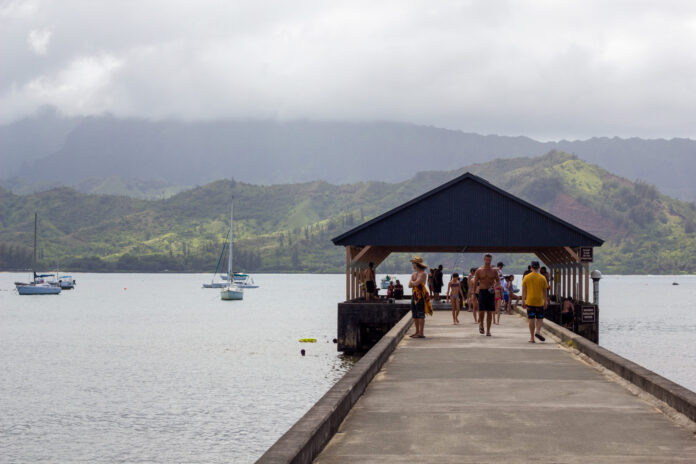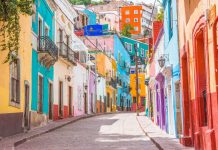Officials from Hawaii’s top travel marketing agency visited Kauai this week, some for the first time since the coronavirus pandemic hit, to report strides in addressing the torrent of tourism on the Garden Isle.
There’s been a burst of investment in Hawaiian cultural programs. The county is developing a shuttle system to reduce rental car reliance by offering visitors a way to travel between the airport, hotels, beaches and attractions. A series of videos produced by the Hawaii Tourism Authority aims to teach visitors how to respect and care for Kauai’s environmentally and culturally fragile resources.
“We’re not your grandfather’s HTA,” said HTA Chief Brand Officer Kalani Ka’ana’ana.
Part of Ka’ana’ana’s job is to reshape visitor expectations of what a Hawaii vacation entails. And that means overhauling Hawaii’s brand to resemble less of a tropical Las Vegas and more of a sanctuary of Hawaiian history, flora, fauna and culture.
“We want them to know that you’re not coming to the playground,” Ka’ana’ana said. “You’re not coming just for sun, sand and surf. You’re coming to our house. You’re coming to a place of deep sacredness.”

Yet at public meetings in Lihue and Princeville, some attendees said they were learning about HTA’s new tourism management programs for the first time, making painfully clear how problematic overtourism has become and how almost imperceptible some attempts to rein it in can be for residents fed up with traffic jams, overcrowded beaches and illegal parking.
“You say you’re preserving Hawaiian culture? They’re living under a blue tarp,” Mahina Laughlin of Wainiha said at the Princeville meeting Wednesday night. “So when the (tourists) tell you, ‘Oh, what’s wrong with you? No more aloha spirit?’ You know what? We barely have our aloha spirit left.”
Growing discontent over excessive tourism has led HTA to look beyond its focus on travel marketing toward a new emphasis on visitor management.
Attracting visitors to the islands is still the agency’s primary mission. But in 2020 HTA launched an initiative aimed at improving souring resident sentiment toward tourism. Created by HTA with community input, a series of county-specific destination management action plans identifies tourism friction points and proposes solutions.
Kauai’s plan, for example, lays out policy efforts to educate visitors about the local customs as a way to combat poorly behaved tourists who trespass on private property, harass wildlife or stomp on the reef. As a result, Kauai has added more park ranger positions. Parking fees for non-residents at some county beach parks are forthcoming.
Many meeting attendees voiced appreciation for such new efforts to make tourism less intrusive. But others emphasized that these initiatives don’t do anything to reduce it.
In the pre-pandemic year of 2019, Kauai hosted 1.37 million visitors — an amount that Kauai Visitor Bureau Executive Director Sue Kanoho equated with overtourism.
She identified 1.2 million visitors as the maximum number of people that Kauai, with its current infrastructure, can reasonably handle in a given year.
“We’re over the top,” Kanoho said.

Federal laws prevent Hawaii from limiting the number of people who travel here. But Kanoho underscored how Kauai’s destination management plan can be used to thwart a major development intended to expand tourism.
In fact, state transportation officials cited the plan last month when it abandoned a proposal to add three new gates at Lihue Airport — a move that would have undoubtedly increased the number of visitors descending on Kauai.
“That was a really big deal,” Kanoho said.
But Louise Sausen of Wainiha expressed doubt that other aspects of the plan, such as educational videos, could really dissuade visitors from parking illegally in neighborhoods to access a beach or hiking trail. Instead, she called for steeper fines and increased police enforcement.
“I don’t leave my house sometimes because I leave my house and I get upset at rude people,” Sausen said. “Why? Because they spent so much money to get here, they can do whatever they want, they can go wherever they want.”
David Dinner of Kilauea commended tourism leaders for improving interagency communication on tourism management strategies. He also applauded steps made by tourism leaders to communicate to airlines the island’s expectations and limitations when it comes to how much tourism it can feasibly handle.
But he urged officials to do more to put teeth behind the island’s vision for a more sustainable level of tourism.
“We can draw a line in our community and say if you don’t come here with a reservation, if you have no place to stay, you get a ticket,” he said. “Because it’s not right to just land here without a plan. People are landing here without a plan, without a place to stay.”
Ka’ana’ana emphasized to more than 50 attendees at the Princeville meeting that he and his colleagues understand residents’ frustrations and aim to do more to restore some semblance of balance between the sometimes opposing forces of Hawaii as a vacation destination and Hawaii as a local community.
“We know we have trust to earn and we know we have work to do,” Ka’ana’ana said.
Sign up for our FREE morning newsletter and face each day more informed.
Sign Up
Sorry. That’s an invalid e-mail.
Thanks! We’ll send you a confirmation e-mail shortly.










